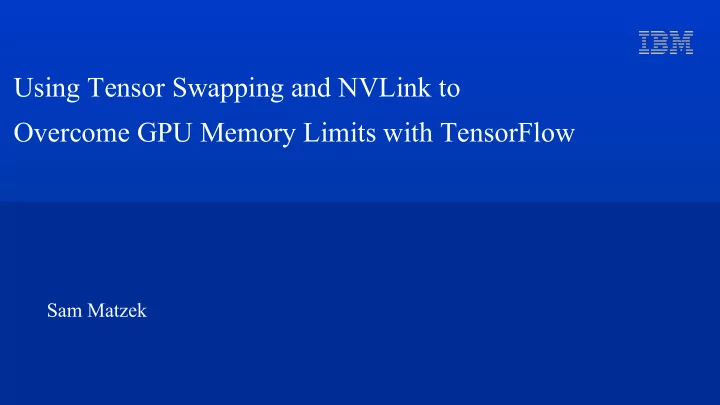

Using Tensor Swapping and NVLink to Overcome GPU Memory Limits with TensorFlow Sam Matzek
Deep learning is memory constrained • GPUs have limited memory • Neural networks are growing deeper and wider • Amount and size of data to process is always growing
GPU Memory Usage GPU memory Tensors Input data (Layer outputs) Kernels loss
Model Training in GPU Memory GPU memory Tensor 3 Tensor 2 Tensor 1 loss
Model Training with Tensor Swapping GPU memory Tensor 2 Tensor 3 Tensor 4 Tensor 1 loss System memory
TensorFlow Large Model Support Graph Modifications GPU CPU A Swap out Swap in B https://arxiv.org/pdf/1807.02037.pdf
Enabling TensorFlow Large Model Support Keras API Estimator API * Examples for TFLMS v2.0.0
What’s possible with Large Model Support? • 10x image resolution - Keras ResNet50 • 10x image resolution - DeepLabV3 2D image segmentation • 5x MRI resolution - 3D U-Net 3D image segmentation Measured with TFLMS v2.0.0 on TensorFlow 1.13, CUDA 10.1, cuDNN 7.5
3D U-Net image segmentation • 3D U-Net generally has high memory usage requirements • International Multimodal Brain Tumor Segmentation Challenge (BraTS) • Existing Keras model with TensorFlow backend
Effect of 2x resolution on Dice Coefficients (higher is better)
“Swapping makes everything slow”
Typical GPU connectivity System Memory System memory bus: 76.8 GB/s CPU PCIe: 32 GB/s GPU GPU NVLin k
POWER9 CPU to GPU connectivity System Memory System memory bus: 170 GB/s CPU NVLink 2.0: 150 GB/s NVLink 2.0: 150 GB/s GPU GPU NVLink 2.0
Effects of NVLink 2.0 on Large Model Support PCIe connected GPU training one high res 3D MRI with large model support NVLink 2.0 connected GPU training one high res 3D MRI with large model support
Effects of NVLink 2.0 on epoch times
Effects of NVLink 2.0 on GPU Utilization
Multi-GPU model training with NVLink 2.0 2.1x faster with HALF the number of GPUs ! http://ibm.biz/3dunet-tflms-multigpu
Patches versus whole image 3.5x 3x faster faster https://arxiv.org/abs/1812.07816
Overhead of Large Model Support with NVLink 2.0 Measured with TFLMS v2.0.0 on TensorFlow 1.13, CUDA 10.1, cuDNN 7.5
Overhead of Large Model Support with NVLink 2.0 Measured with TFLMS v2.0.0 on TensorFlow 1.13, CUDA 10.1, cuDNN 7.5
Overhead of Large Model Support with NVLink 2.0 DeepLabV3 on POWER9 with 32GB NVIDIA Volta V100 1.2 GB transferred to GPU, GPU utilization 81% 438 GB transferred to GPU, GPU utilization 89% LMS enabled 1.4 TB transferred to GPU, 148 GB transferred to GPU, GPU utilization 64% GPU utilization 90% 826 GB transferred to GPU, GPU utilization 84% Using bs=16, fine_tune_batch_norm=true, measured on 32GB GPU with TensorFlow 1.13, CUDA 10.1, cuDNN 7.5
Large Model Support with NVLink 2.0 • Tensor swapping can be used to overcome GPU memory limits • Allows training of: • deeper models • higher resolution data • larger batch sizes • NVLink 2.0 between CPU and GPU allow tensor swapping with minimal overhead
More information TensorFlow Large Model Support https://github.com/IBM/tensorflow-large-model-support TFLMS: Large Model Support in TensorFlow by Graph Rewriting https://arxiv.org/pdf/1807.02037.pdf TensorFlow Large Model Support Case Study https://developer.ibm.com/linuxonpower/2018/07/27/tensorflow-large-model-support-case-study-3d-image-segmentation/ Performance of 3DUnet Multi GPU Model for Medical Image Segmentation using TensorFlow Large Model Support http://ibm.biz/3dunet-tflms-multigpu Fast and Accurate 3D Medical Image Segmentation with Data-swapping Method https://arxiv.org/abs/1812.07816 Data-parallel distributed training of very large models beyond GPU capacity https://arxiv.org/abs/1811.12174 POWER9 server with NVLink 2.0 connections between CPU and GPU (IBM AC922): https://www.ibm.com/us-en/marketplace/power-systems-ac922
Recommend
More recommend